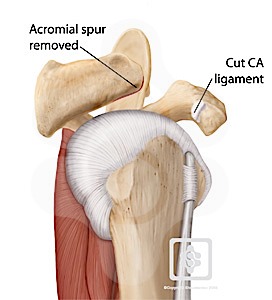Subacromial Impingement
Also Known as: Trapped Tendons, Tendinitis, Bursitis
What is it?
The four muscles that raise and lower the arm (and their respective tendons) are collectively known as the rotator cuff . The rotator cuff lies under the roof of the shoulder (an extension of the shoulder blade known as the acromion ). The space between the acromion and the rotator cuff tendons is filled by the subacromial bursa . This bursa is a fluid filled sac that allows for smooth gliding of the rotator cuff under the acromion with overhead movements of the shoulder.
The rotator cuff works a depressor and centraliser of the humeral head in the glenohumeral joint. As the arm is elevated the rotator cuff depresses the humeral head allowing it to glide easily underneath the acromion.
Should any abnormality occur affecting the rotator cuff this would lead to dysfunction of the rotator cuff. Therefore as the arm is elevated, the depressing and centralising effect would be lost and the humeral head would ride upwards closer to the acromion at risk of causing impingement. Pathologies that could do this are those directly affecting the rotator cuff such as:
- Rotator cuff strain
- Partial or full thickness tear
- Calcific tendonitis
- A tendonopathy due to chronic overuse.
- Indirect causes:
- Glenohumeral instability
- Labral tears, in particular SLAP tears
- Abnormal muscle patterning problems of the shoulder.
The acromion differs in individuals normally (morphological variants). These were described by Bigliani as type I, type II or type III. Type I is flat, type II is curved and type III hooked. A person with a type II or type III acromion would be at a higher risk of impingement due to the narrowing of the acromiohumeral gap and bursal space.
In addition to the above, with advancing age people tend to develop a bone spur on the front and side of the acromion. This further reduces the subacromial space increasing the risk of impingement.
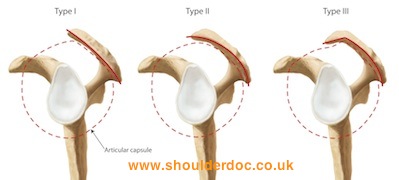
Therefore somebody with a rotator cuff injury who has a type III acromion and is their 50’s has a very high risk of developing significant impingement compared to a patient in their 20’s sustaining a supraspinatus strain who may have a type I acromion and no spurs.
The rotator cuff and acromion will then rub against one another, causing a painful condition known as impingement. Each time the arm is raised there is a bit of rubbing on the tendons and the bursa between the tendons and the acromion, which may cause pain and inflammation.
Impingement may become a serious problem for some people and disturb their normal activities. This is when treatment is needed.
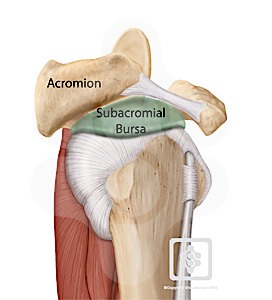
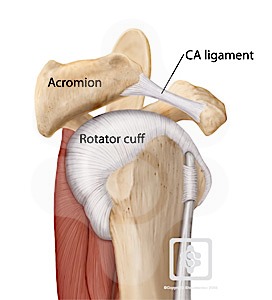
| Subacromial bursa under the acromion Subacromial bursa removed to show rotator cuff
|
| Acromial bone spur developed off acromion Bone spur removed by surgery with cut ligament |
Treatment
Treatment of impingement syndrome involves:
1. Painkillers and anti-inflammatory medications
2. Physiotherapy - the key part of management to work on good posture, shoulder blade positioning and strengthening of the weakened rotator cuff muscles
3. Injections - reduces inflammation and control the pain, allows the rotator cuff muscles a chance to recover and improve with the exercises
4. Surgery - Rarely Surgery is required - the goal of any surgery to reduce the effects of impingement, by increasing the amount of space between the acromion and the rotator cuff tendons, which will then allow for easier movement and less pain and inflammation. The operation performed is Arthroscopic Subacromial Decompression (ASD)
Prevention
- Avoid excessive overhead activities.
- Strengthen your shoulders and do not try to play or work through the pain.
Terms Explained:
Bone Spurs = small deposits of calcium, which build up along the edges of the bones. If they become big enough, or are further complicated by conditions such as impingement, they can become quite painful as tendons and other native tissues within the shoulder joint rub against them, causing inflammation and pain
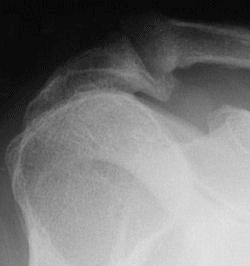
Acromial bone spur seen on x-ray
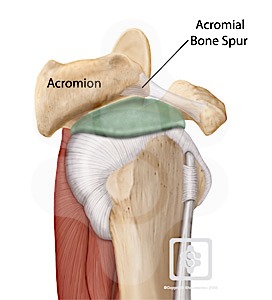
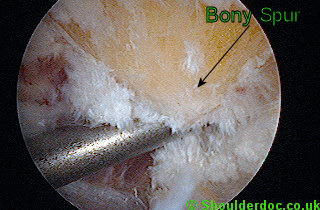
Acromial bone spur seen at arthroscopy



